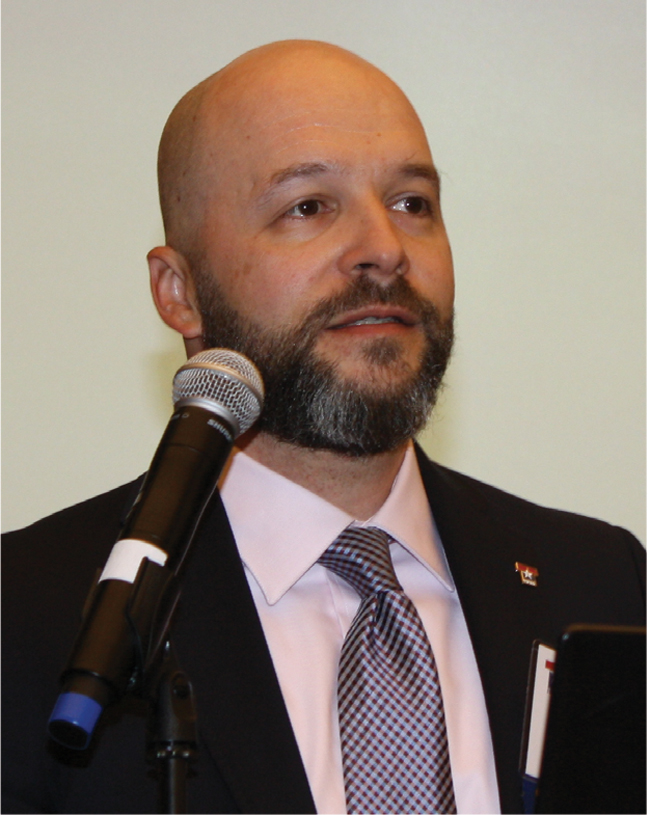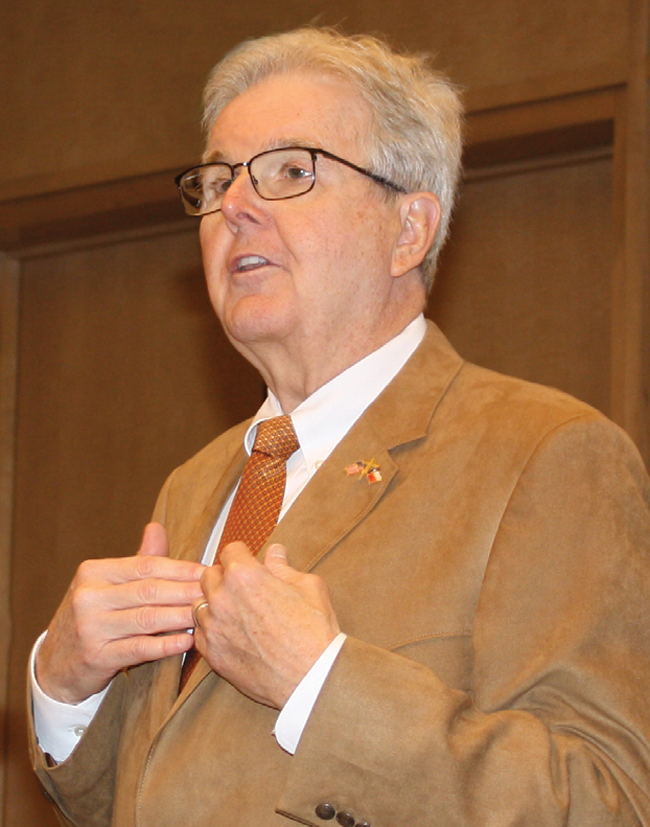
Federal Frustrations Don’t Foil Texas
By Danny Boyd
AUSTIN, TX.—In the face of market swings, challenging federal policies and political posturing, Texas oil and gas producers prefer to look on the bright side: The industry is pumping billions into the Lone Star State’s economy, creating jobs and meeting rising global hydrocarbon demand as naysayers tout what some analysts insist is a fictious “energy transition.”
With the oil market always susceptible to geopolitical developments, surging liquefied natural gas exports during the next four years from terminals under construction will boost natural gas demand and give prices and producers a needed shot in the arm, predicted Jud Walker, president and chief executive officer at Houston-based EnerVest Ltd. and chairman of the Texas Independent Producers and Royalty Owners Association.
“It sets up a big year for natural gas in 2025 and beyond, despite the Biden administration’s very politicized decision to pause permit reviews for new LNG facilities,” he told TIPRO members at the group’s annual meeting, held at the Crescent Hotel in Fort Worth on March 6-7.
The pause hurts the United States and its allies at a time in which producers are weathering their share of challenges, Walker said. Those include fewer young professionals choosing oil and gas career paths, a soft acquisition and divestiture market, a declining rig count, and the prospect of 350,000 wells being rendered uneconomical by the methane tax authorized by the Inflation Reduction Act of 2022.
On the brighter side, institutional investors who fled the oil and gas space because of environmental, social and governance mandates and other issues are showing renewed interest as producers exercise capital discipline. Oil and gas companies reinvested 58% of cash flow into operations last year, Walker pointed out.
With growth slow outside the Permian, the industry nonetheless is benefiting from reclassifying Tier 2 and Tier 3 acreage from better completions and longer laterals across unconventional basins, he said. Independents also are leading the charge drilling less explored secondary zones.
Institutional investors have been returning to the oil and gas space as the segment shows stronger returns, says TIPRO Chairman Jud Walker. Walker, who is chief executive officer of EnverVest Ltd., reviewed market conditions and developments during his remarks at the association’s 2024 Annual Meeting, March 6-7 in Fort Worth.
The mergers and acquisitions market also is looking up, Walker assessed, with equity markets supporting deals worth a collective $196 billion last year, and average values up 70% to $900 million.
Permian Expansion
The largest M&A deals include ExxonMobil’s pending $59.5 billion acquisition of Pioneer Natural Resources. With the merger expected to close in the second quarter, ExxonMobil plans to boost Permian production with the latest drilling and completion technologies and accelerate Pioneer’s goals for achieving net-zero emissions, said Cory Quarles, Permian business general manager for ExxonMobil.
At closing, ExxonMobil’s Permian production will be 1.3 million barrels of oil with plans to grow volumes to about 2 million barrels of oil equivalent a day in 2027 across its advantaged 1.4-million-acre position, Quarles told TIPRO.
“When we look at Pioneer, we see one of the best operators in the basin that excels at execution,” he related. “We are looking forward to bringing together the best of our organizations to achieve what neither of us could do alone.”
Quarles estimated that more than 90% of the Permian’s oil and gas will remain in the ground based on the industry’s current development approach. However, he said, ExxonMobil has plans to improve recovery by drilling benches simultaneously and through technological advancements to help control fracture placement, direction, length and width.
In the meantime, production companies will continue to look for ways to raise capital from the sale of noncore assets to generate funds to put back into ground, members of an A&D minerals panel said. Investors continue to show interest in acquiring overriding royalties from established operators looking to raise capital, said Chris Atherton, CEO at Energynet Inc.
Consolidation in the minerals and royalties space is just getting started, according to Chris Conoscenti, CEO of Sitio Royalties. Conoscenti estimated that over a dozen minerals businesses valued at more than $1 billion each and numerous opportunities in the $250 million-$1 billion range may become actionable in the future.
Larger production companies combining assets across the Permian and elsewhere are giving smaller operators opportunities to buy up noncore acreage shed by bigger companies, said Jim Wilkes, president of Texland Petroleum LP. Fort Worth-based Texland hopes to add conventional acreage on the Permian’s Central Basin Platform, where the company operates about 1,200 wells producing from the upper and lower Clear Fork, the San Andres and other benches.
“I think the majors still own a ton of conventional acreage in the Permian and will begin to sell that off,” Wilkes, a past chairman of the Independent Petroleum Association of America, said during a producer panel discussion.
However, regulations may diminish operator returns, he warned, pointing to the methane tax that takes effect this year and the potential impact of proposed Statewide Rule 8 pending before the Texas Railroad Commission. Introduced by Commissioner Jim Wright, the rule would require closed-loop systems during drilling that Wilkes estimated could raise the cost of a $1 million vertical well by $250,000-$300,000, a potentially devastating increase for conventional operators such as Texland.
Currently, Texland installs lined pits and buries cuttings in place after it finishes drilling. Similar to standards in New Mexico, SWR 8 would require operators to separate cuttings into roll-off bins and transport them to approved waste disposal facilities, Wilkes said.
“We have talked to every railroad commissioner and we have run a campaign to get everybody involved that we can because it is such a critical issue, and they were trying to slip it in without people recognizing the impact,” he said.
Railroad Commission Chairman Christi Craddick told TIPRO that the agency would submit an updated SWR 8 for another round of public review during the next six months. Initial industry feedback generated more input than any previous proposal during her almost nearly 12 years on the commission, she said. The RRC aims to finish the process by the end of the year in keeping with statutory requirements, Craddick added.
Federal Challenges
The RRC continues to navigate a labyrinth of federal issues, Craddick said. Earlier comments from the RRC and the Texas Commission on Environmental Quality were disregarded in Washington, she assessed, and the three-member commission subsequently voted to sue.
At the Texas Legislature’s behest, the commission hopes to soon obtain permitting primacy from the U.S. Environmental Protection Agency over Class 6 wells for carbon dioxide injection, Craddick reported. The EPA has five staffers reviewing permits on Class 6 wells in a process that can drag on for three years, she said. The RRC could do it in six months, she contrasted, noting that Louisiana, North Dakota and Wyoming already have primacy.
Texas Railroad Commission Chairman Christi Craddick addresses state and federal regulatory issues affecting the state’s oil and natural gas industry. Craddick told TIPRO that the commission continues to navigate complicated federal issues and suggested many Washington policies undermine the industry and state.
According to Craddick, the RRC also is working to sort out unanticipated requirements not found in statute for spending $79 million from the U.S. Interior Department to help plug orphaned wells. The state agency, which received the funds on Feb. 1, plugs 1,000 orphaned wells a year and has 8,000 such wells on the books, at a total plugging cost of $330 million. Initial federal funding of $25 million was paid to plug 730 additional wells.
To use the latest monies already in the RRC’s account, the state cannot claim CO2 credits, although private companies can, Craddick said. Additional requirements call for methane monitoring on some plugged wells where scientific analysis demonstrates no leaks can exist, she related.
Also, the RRC is required to ensure that historic sites, including those of significance to Native Americans, are not adversely affected. The U.S. Fish and Wildlife Service must sign off on projects, but the USFWS does not yet know how to manage the program, Craddick reported.
On the whole, policies meted out in Washington are limiting the energy industry and Texas’ potential as a state, she said. Nevertheless, she said, recent data reveals the oil and gas industry put $26 billion in the state’s economy last year from taxes and royalty payments while employing 480,000 people and paying an average salary of $124,000, Craddick said.
The industry has helped fuel a surging state economy with a $1.9 trillion GDP, Texas Lieutenant Governor Dan Patrick told attendees. Oil-and-gas-generated severance taxes are supporting state programs that include $4 billion for border security, he said.
The Biden administration’s pause on new LNG permits is a targeted attack on Texas because of the state’s efforts to rein in illegal immigration, Patrick charged. Aside from the border, expanding the state’s power grid with the help of natural gas producers is a major priority as Texas’ population surpasses 30 million, up 11 million since 2000, the lieutenant governor remarked.
On Jan. 16, the state set an all-time high for electricity demand at 87,000 megawatts. About 700 gas-fired power plants contributed almost all the 55,000 MW from a bloc of generators that also included coal and nuclear, Patrick said, adding that half of those gas plants are 40-50 years old. Although renewables are contributing, they are not reliable, he warned. Therefore, Patrick stated, Texas needs to quickly build at least 10,000 MW of natural gas-fired generation to ensure the grid’s reliability.
The state is seeing new interest from power companies and investors, Texas Lieutenant Governor Dan Patrick tells TIPRO. Patrick attributed much of that interest to SB 2627, which seeks to spur natural-gas-fired power plant construction by providing 20-year loans at 3% interest, a 10% completion bonus and a property tax abatement.
According to Patrick, to spur construction, lawmakers passed SB 2627 during the 88th Texas Legislature to provide 20-year loans at 3% interest for gas-fired generation. Also included are a 10% completion bonus and a property tax abatement. The state is getting interest from power generation companies and investors.
“If we don’t have people take us up on this and build plants, then the state will have to build them,” Patrick assessed.
Hydrocarbon Demand
In the meantime, Texas oil and gas producers will continue to help meet growing global oil demand. Global energy demand will be met by a variety of forms, including a lot of oil and gas, despite policymakers’ efforts to dictate sources, maintained James Wicklund, managing director of client relations and business development at oil and gas investment banker Parks Paton Hoepfl & Brown.
By 2025, solar and wind will represent an increasing part of energy production, he forecasted, but all segments except for coal also will be in higher demand. Trends that include the construction of more coal-fired power plants in China and India mean lofty near-term global net-zero goals will not be met, Wicklund insisted, adding that China began operating 102 new coal plants.
“If you think they are going to switch them some time in the next year to natural gas, I am going to find something to sell you before the conference ends,” he quipped.
With 3 billion cubic feet of demand expected for LNG terminals coming on line in the next three years, prospects for gas producers will improve, he said.
Author, podcaster and filmmaker Robert Bryce told TIPRO that no energy transition is underway, despite the claims of environmentalists, their political allies and media.
“It is a very well-funded marketing campaign being funded and promoted by some very powerful nongovernmental organizations and the Biden administration,” Bryce reported. To demonstrate the extent to which the concept had been promoted, the term “energy transition” occurred 46 times in the New York Times in 2021, he observed, but that number jumped to 162 in 2023 as the administration and environmentalists continued to tout the concept.
Facts do not support such claims, he insisted. In one example he cited, from 2004 to 2022, $4.1 trillion was spent globally on solar and wind, but hydrocarbon consumption grew 3.4 times faster, comparing consumption based on exajoules, which are the equivalent of 1 quadrillion Btus.
According to Bryce, total global energy use in 2004 was 445 exajoules, which grew to 604 exajoules by 2022. Of that, hydrocarbon consumption increased by 110 exajoules, while the massive spending on wind and solar expanded its output by only 32 exajoules.
Moves by western governments to promote alternative energy and cut global CO2 emissions are damaging the economy while also falling short on their goals, Bryce assessed. The United States has reduced CO2 emissions more than any other country, but has joined western European nations in the arrogant assumption that the rest of the world will follow green energy initiatives, he said.
Germany invested $500 billion toward running the economy on renewables, he detailed, but the country is effectively deindustrializing as plants move elsewhere and the economy faulters. Meanwhile, Bryce observed, 136,000 MW of coal-fired generation is under construction in China and India, which demonstrates coal will endure as an energy source.
In the meantime, he said, there is a growing global backlash about the placement of wind turbines. New York, California, Michigan and Illinois state governments have taken away local governments’ zoning authority because they often seek to rein in windmill placement.
For other great articles about exploration, drilling, completions and production, subscribe to The American Oil & Gas Reporter and bookmark www.aogr.com.


















